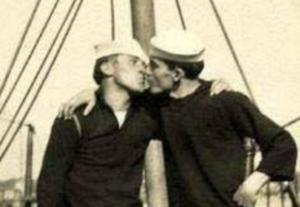
 The ban on homosexuals in the military was introduced during the second world war. At that time, homosexuality was seen as a mental disorder and the ban was based on existing sodomy laws. Today, like heterosexuality, psychoiogists see it as constitutive of a person’s deepest personal identity and essentially unalterable (Broyles 1993). Although it is no longer considered a disorder, other arguments, such as threats to security and unit effectiveness, have been raised to prevent the ban’s repeal. The Secretary of Defense, Dick Cheney, has dismissed the security argument as “an old chestnut,” however, many soldiers maintain that the mutual trust and cohesion that make units effective in combat would be undermined if the presence of homosexuals was known and open (American Survey 1992).
The ban on homosexuals in the military was introduced during the second world war. At that time, homosexuality was seen as a mental disorder and the ban was based on existing sodomy laws. Today, like heterosexuality, psychoiogists see it as constitutive of a person’s deepest personal identity and essentially unalterable (Broyles 1993). Although it is no longer considered a disorder, other arguments, such as threats to security and unit effectiveness, have been raised to prevent the ban’s repeal. The Secretary of Defense, Dick Cheney, has dismissed the security argument as “an old chestnut,” however, many soldiers maintain that the mutual trust and cohesion that make units effective in combat would be undermined if the presence of homosexuals was known and open (American Survey 1992).
William Broyles, an ex-Marine, believes that the bond formed between soldiers, which prevents them from fleeing and allows them to fight, is homoerotic in nature. He believes that homosexuality is incompatible with the “combat bond” because “homosexual love can’t hold together a unit of more than two men.” The problem, he believes, lies in the inability for all members to love the group if some within the group love one another. He explains that combat training expands the power of “homosexual love to the entire unit” so that “everyone becomes lovers, but without sex.” He states soldiers fight in combat because “it takes more courage to run, the natural response, than to fight, because to run would be to betray your buddies.” To Broyles, this homoerotic bond is fragile, and “survives only if the homosexuality beneath it is repressed… it strengthens men in combat only if they can love their fellow soldiers without fear of undermining their own sexuality.”
This argument is complex because it makes two big assumptions. First, it assumes that allowing homosexuals to be open about their orientation would destroy group cohesion, and second, that group cohesion is essential to combat performance. The first point is, at most, an abstract opinion which has no empirical evidence in its support. Homosexuals in the past have served in cohesive groups in the military despite the fact that their comrades were well aware of their orientation. How much this knowledge affected group cohesion, if at. all, has not been studied extensively due to the military’s current poicy; you can’t study what you pretend not to know.
The notion that soldiers fight to avoid the pnmary-group shame or embarrassment that failing to act under pressure might bring or to avenge the death of a fallen buddy is central to the meaning of cohesion and the argument for its importance in combat. Explanations like William Broyles’s are popular opinions; they reflect sentiments of many in the military and out. Of the forty nine UC Davis students I surveyed, 74% thought that allowing open homosexuals in the military would cause more conflict, and 71% thought that it would affect the performance heterosexual soldiers. Many cohesion-combat studies conducted since World War I and II have reinforced this idea, and to an extent, may have nurtured this popular opinion. Unfortunately, these studies lack any hard evidence to substantiate the claim that there is a strong link between group cohesion and combat effectiveness.
Garvey and Dilulio have analyzed several of the most well known studies and have found “the empirical evidence for the link inconclusive.” According to Garvey and Dilulio, the data in Stouffer et aI’s 1949 study has shown that cohesion was a byproduct of primary group relations, and that it mattered as far as how soldiers defined their missions, but did not prove that more cohesive units outperform less cohesive units in combat engagements. Similarly, they found Marshall’s claim that the presence of a comrade “enables an infantry soldier to keep going with his weapon” was not supported by any “systematic evidence that the propensity for soldiers to fire varied directly with the cohesiveness of their units.”\= Essentially he proved that “primary-group relations mattered greatly to soldiers in combat, but not that soldiers to whom it mattered greatly actually fought better” (Garvey and Dilulio 1993).
On the other side of the coin, less cohesive units have been seen to perform just as well as those that are more cohesive. Manning and Marlowe pointed out that troops in Korea fought well despite the introduction of a rotation system which undermined group identification. Further, there was no systematic evidence from the Vietnam War that combat units that were pasted gether at the last minute performed any worse than those that had trained, gone in country, and had previously faced fire together (Garvey & Dilulio 1993).
The cohesion argument has been used before by those opposing racial integration of the armed forces. Since Harry Truman’s order, the Army, Navy, and Air Force are now considered some of the best integrated institutions in America, but this comparison falls short because skin color is not a perfect parallel to sexual preference. The , integration of women would be a better parallel, but women who serve in the armed forces are still not allowed to go into combat (American Survey 1992).
The opinions of most of the students I survyed seem to reflect the state of racial and sexual integration. Although most thought that repealing the ban would reduce effectiveness, the current argument against sex integration, many believed that the gay-straight conflict would diminish, like the racial conflict, over time. It is also interesting to note that 78% were against seggregation. Despite their belief that allowing homosexuals to be open about their sexuality would cause more conflict and hinder the performance of the soldiers, the majority backed Clinton’s proposal to repeal the ban. 94% of the students polled thought that homosexuals should be allowed to remain in the military and 88% thought they should be allowed to join.
Whether sex of any kind between soldiers undermines cohesiveness and whether cohesiveness matters in combat have yet to be substantiated by any empirical evidence. It is clear, however, that cohesiveness matters to the men who are in the military. It is also clear that allowing homosexuals to be open about their sexuality is, to some, threatening. The belief that out-homosexuals are a threat to the cohesive bond, and whether that bond has an effect on combat effectiveness, are the foundation of the military’s argument maintaining the ban. The lack of evidence for either claim makes this foundation particularly vulnerable. From the small survey I conducted, it seems that most college students are in favor of President Clinton’s proposal, despite the potential problems. It appears that if these small tremors of student opinion in reflect those of the rest of the American landscape, the ban against allowing homosexuals to be open in the military will topple in the wake of Clinton’s seismic reform.
References
American Survey 1992. “Out of the Locker: Homosexuals in the military.” The Economist v.325 n.7786: 26
Broyles, W. 1993. “Of Lust and Arms” Playboy vAO n.6: 94.
Garvey, G. 1. & Dilulio, J. 1. 1993. “Only Connect: Cohesion vs. combat effectiveness.” The New Republic v.208 n.17: 18
Brett Dixon May 26, 1993




Related
role of the trickster
leap of faith
Syntheology